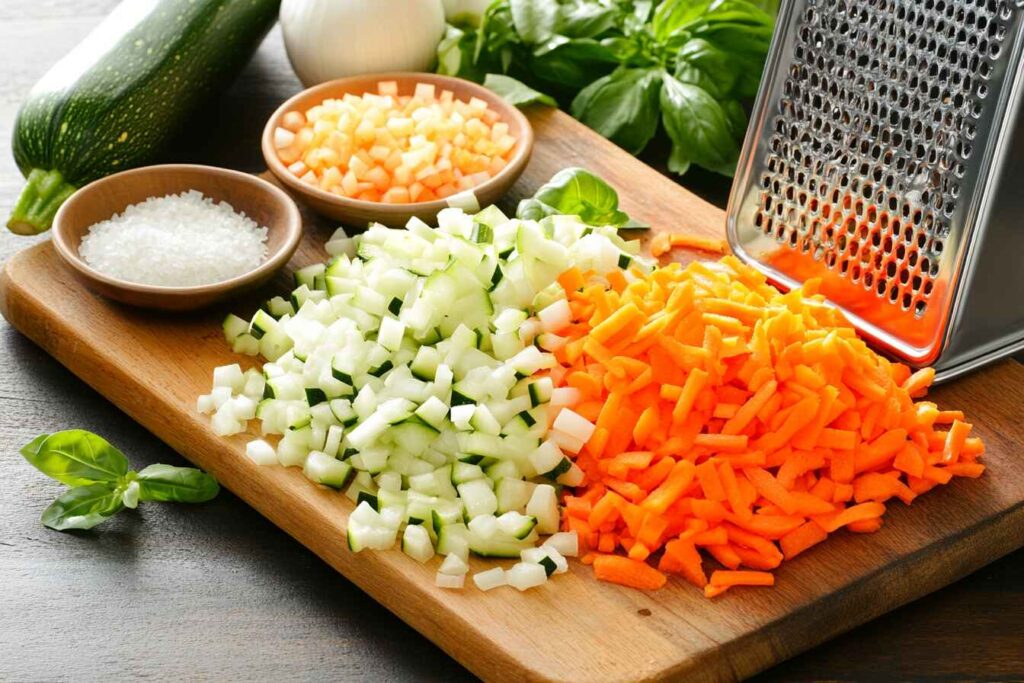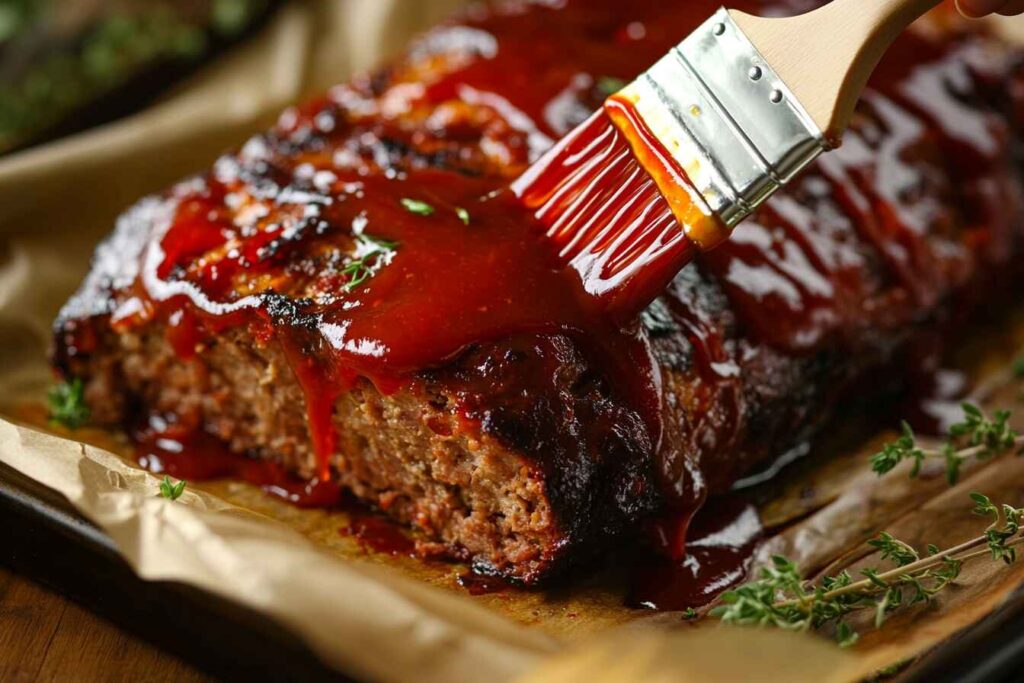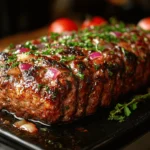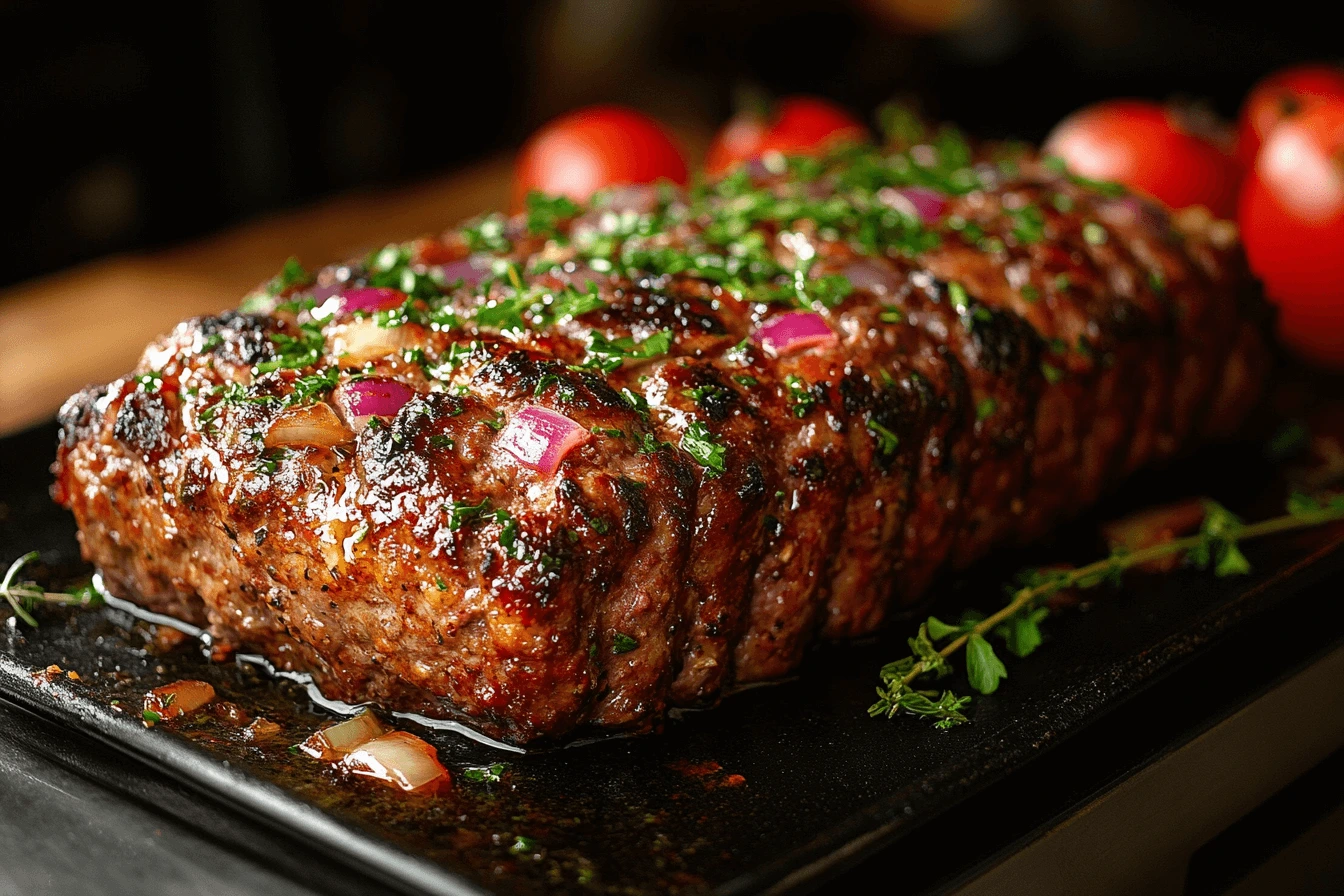Moist meatloaf, is a timeless comfort food beloved for its hearty, flavorful, and satisfying qualities. However, achieving the perfect meatloaf one that is moist and tender instead of dry and crumbly requires attention to detail. The secret to moist meatloaf lies in the careful selection of ingredients, proper preparation techniques, and precise cooking methods.
Moist meatloaf is more than just a delicious dish; it’s a testament to culinary balance. The right blend of meat, thoughtful use of binding agents, and cooking practices make all the difference. This guide explores the essential tips and tricks to help you master the art of making a perfectly moist meatloaf every time.
Table of Contents
Key Ingredients
Achieving moist meatloaf begins with selecting and combining the right ingredients. The foundation of this dish relies on elements that provide structure, flavor, and moisture.
Choosing the Right Meat Blend
The type of meat you use plays a significant role in the final texture of your meatloaf. A mix of meats is often the key to success:
- Meat Blend: Use a mix of beef with 15-20% fat, or even veal for optimal moisture. Learn more about using substitutions like Stove Top Stuffing instead of breadcrumbs.
- Veal or Turkey: For a lighter version, ground veal or turkey can be included. Be cautious, though, as lean meats require additional moisture from other ingredients to prevent dryness.
The Importance of Eggs and Breadcrumbs
Eggs and breadcrumbs serve as the backbone of a cohesive, moist meatloaf.
- Eggs: These are crucial for binding the mixture together, ensuring the loaf doesn’t fall apart. They also contribute to the soft texture.
- Breadcrumbs: Acting as a sponge, breadcrumbs soak up liquids and hold moisture within the loaf. For added flavor, consider using seasoned breadcrumbs or panko.
Liquid Additions: Milk, Broth, or Sauces
Moisture-rich liquids are indispensable for a tender meatloaf:
- Milk: A traditional choice, milk softens the breadcrumbs and integrates moisture throughout the loaf.
- Broth: Chicken, beef, or vegetable broth can add flavor while maintaining juiciness.
- Worcestershire Sauce or Tomato Paste: These add depth of flavor and a subtle tang, enhancing the dish’s overall richness.
Vegetables as Moisture Boosters

Incorporating finely chopped vegetables not only elevates the flavor but also keeps the meatloaf moist. Some excellent options include:
- Onions: Sweat or sauté them before adding to the mix for sweetness and moisture.
- Bell Peppers: These add a slight crunch and vibrant flavor while contributing water content.
- Carrots and Zucchini: Grated carrots or zucchini blend seamlessly into the loaf, ensuring a tender bite.
Preparation Techniques
Even with the perfect ingredients, how you prepare and handle your meatloaf mixture can make or break its moisture and texture. These techniques ensure that your meatloaf remains tender and flavorful.
Mixing Meatloaf Without Overhandling
One of the most common mistakes when preparing meatloaf is overmixing the ingredients. Overworking the meat can lead to a dense, tough texture.
- Gentle Handling: Use your hands or a spatula to mix the ingredients gently. Stop as soon as everything is combined.
- Layered Mixing: Start by mixing wet ingredients (milk, eggs, sauces) with breadcrumbs and seasonings. Then, fold the wet mixture into the meat for even distribution.
- Cooling the Mixture: If the mixture feels too warm or sticky, chilling it for a few minutes before shaping can prevent overhandling and ensure a firm but moist loaf.
For additional insights, explore the article How to Keep Meatloaf from Falling Apart.
The Role of Binding Agents
Binding agents are critical for keeping the meatloaf intact while retaining moisture. While eggs and breadcrumbs are the standard, you can get creative with alternatives:
- Oats: Rolled oats provide a heartier texture and soak up liquid like breadcrumbs.
- Crushed Crackers: A great way to use up pantry staples, crackers add a buttery richness.
- Mashed Potatoes: For a gluten-free option, mashed potatoes bind the meatloaf while boosting moisture.
Adding Vegetables for Moisture
As discussed earlier, vegetables like onions, carrots, and zucchini are excellent for maintaining moisture. Here’s how to incorporate them effectively:
- Grating or Mincing: Grated or finely chopped vegetables integrate seamlessly into the meat mixture.
- Pre-Cooking: Sauté vegetables like onions, garlic, and peppers before mixing. This prevents them from releasing excess water while baking, which could make the loaf soggy.
Shaping the Meatloaf
The way you shape your meatloaf can affect how it cooks:
- Loaf Pan vs. Freeform: A loaf pan keeps the shape consistent but can trap grease. A freeform loaf on a baking sheet allows fat to drain away while still retaining moisture.
- Thickness: Avoid making the loaf too thick; aim for about 2-3 inches in height. This ensures even cooking without drying out the center or edges.
Enhancing Flavor with Seasoning
Proper seasoning not only elevates flavor but also helps balance moisture:
- Salt and Pepper: Season generously to highlight the meat’s natural flavors.
- Herbs and Spices: Add depth with parsley, thyme, garlic powder, or smoked paprika.
- Cheese: Incorporate shredded cheese for both flavor and added moisture.
Cooking Methods
How you cook your meatloaf is just as important as the ingredients and preparation. Proper temperature control, baking techniques, and additional steps like glazing ensure your meatloaf comes out moist and delicious.
Oven Temperature and Baking Time
The cooking temperature and duration have a direct impact on the texture and moisture level of your meatloaf.
- Optimal Temperature: Bake meatloaf at 350°F (175°C). This moderate heat allows the loaf to cook evenly without drying out the outer edges.
- Baking Time: A typical meatloaf takes about 1 hour to 1 hour 15 minutes to cook, depending on its size and thickness. Always rely on a meat thermometer for accuracy. The internal temperature should reach 160°F (71°C) for beef or pork, and 165°F (74°C) for poultry.
Using a Water Bath or Steam
Adding moisture to the cooking environment can make a significant difference in your meatloaf’s texture.
- Water Bath: Place a baking dish filled with water on the rack below your meatloaf. The steam generated during cooking helps to keep the loaf moist.
- Covering the Loaf: Cover with foil initially to trap steam and uncover later for a crisp crust. Dive deeper into whether to Cook Meatloaf Covered or Uncovered.
The Benefit of Covering the Loaf
If you prefer a moist loaf with a soft crust, covering it during baking is essential.
- Foil Tent: Use foil to create a tent over the loaf. This allows the heat to circulate while retaining moisture.
- Lidded Pans: If baking in a loaf pan, a lidded option is a convenient alternative to foil.
Using Glazes and Sauces

A glaze not only adds flavor but also seals in moisture.
- Classic Ketchup Glaze: Mix ketchup, brown sugar, and a splash of vinegar or Worcestershire sauce for a sweet-tangy topping.
- BBQ Sauce: For a smoky twist, brush barbecue sauce over the loaf during the last 15 minutes of baking.
- Savory Options: Experiment with mustard, tomato paste, or even pesto for a more robust glaze.
Monitoring the Internal Temperature
Using a meat thermometer ensures perfect results:
- Digital Thermometer: Insert the thermometer into the center of the loaf for an accurate reading.
- Avoid Guesswork: Meatloaf that is overcooked will lose its juiciness, while undercooked meatloaf is unsafe to eat.
Resting the Meatloaf
Once the meatloaf is removed from the oven, allow it to rest for 10-15 minutes before slicing. Resting lets the juices redistribute throughout the loaf, preventing them from escaping when you cut into it.
Top Tips for Moist Meatloaf
Mastering moist meatloaf is about fine-tuning every detail, from choosing the right ingredients to perfecting your cooking techniques. These top tips will ensure consistently tender and juicy results.
Avoiding Dryness: Fat Content Matters
Fat is crucial for a moist and flavorful meatloaf. Without enough fat, your meatloaf will turn out dry and crumbly.
- Choose Meat Wisely: Opt for ground beef with a fat content of at least 15-20%. For added richness, blend in ground pork, which has a naturally higher fat content.
- Add Fats Strategically: Incorporate fatty ingredients like grated cheese, sour cream, or even a dollop of mayonnaise into the mixture for extra moisture.
- Avoid Lean-Only Options: If using lean meats like ground turkey or chicken, add extra moisture from liquids or vegetables to compensate.
Resting the Meatloaf After Baking
Resting is a vital step often overlooked in the process of making meatloaf.
- Why Resting is Important: When meatloaf cooks, its juices are driven toward the edges. Allowing it to rest for 10-15 minutes before slicing lets these juices redistribute evenly.
- How to Rest Properly: Cover the meatloaf loosely with aluminum foil while it rests to retain heat without trapping steam, which could make the crust soggy.
Using Glazes and Sauces to Lock in Moisture
A glaze isn’t just for flavor; it also acts as a protective barrier that seals in moisture.
- Double Coating: Apply a thin layer of glaze at the start of cooking and then brush on more during the last 10-15 minutes. This ensures both depth of flavor and a shiny finish.
- On the Side: Serve extra sauce on the side, such as gravy, ketchup, or mushroom sauce, to drizzle over slices for added juiciness.
Experiment with variations like Meatloaf with Stove Top Stuffing to expand your recipe repertoire.
Incorporating Hidden Moisture Sources
Hidden moisture sources can elevate your meatloaf to new levels of tenderness.
- Vegetable Purees: Blend sautéed onions, carrots, and celery into a smooth puree and mix them into the meat mixture for both flavor and moisture.
- Cheese Fillings: Add a layer of shredded or sliced cheese in the center of the loaf for a gooey surprise that enhances moisture.
- Liquid Additions: A splash of cream, broth, or even apple juice can infuse moisture into the mixture without altering the flavor drastically.
Experimenting with Cooking Techniques
Trying alternative cooking methods can help you achieve a moist meatloaf every time.
- Slow Cooker Meatloaf: Cooking meatloaf in a slow cooker allows for gradual heat, preserving moisture. Line the slow cooker with parchment paper to make removal easier.
- Sous Vide: For a gourmet touch, use sous vide to cook the meatloaf at a precise temperature before browning it in the oven for a crispy crust.
- Smoked Meatloaf: Smoking meatloaf at low heat for several hours introduces a unique flavor while keeping the loaf moist.
Portioning for Consistent Results
Consider adjusting the size and shape of your meatloaf for more consistent cooking:
- Individual Portions: Make mini meatloaves or use a muffin tin for individual servings. These cook faster and maintain their moisture more easily.
- Even Shape: Whether freeform or in a pan, ensure the loaf’s thickness is consistent to prevent uneven cooking.
FAQs
To help perfect your meatloaf-making skills, here are answers to some common questions and solutions to frequent issues.
How Do I Know When My Meatloaf is Done?
The best way to ensure your meatloaf is fully cooked without overcooking is to use a meat thermometer. Insert the thermometer into the center of the loaf:
- For beef : The internal temperature should reach 160°F (71°C).
- For poultry: Aim for 165°F (74°C).
Visual cues like clear juices or a firm texture can be helpful but aren’t as reliable as a thermometer.
Can I Use Alternatives to Breadcrumbs?
Yes, there are many substitutes for breadcrumbs if you’re looking for gluten-free or creative options:
- Rolled oats: Provide a hearty texture and work well in savory meatloaf.
- Crushed crackers or pretzels: Add flavor and act as an effective binder.
- Cooked rice or quinoa: Perfect for gluten-free versions.
- Mashed potatoes: A soft, starchy alternative for an ultra-moist loaf.
Why Does My Meatloaf Fall Apart?
If your meatloaf crumbles when sliced, it may be due to one of the following reasons:
- Lack of Binding Agents: Ensure you include enough eggs and breadcrumbs to hold the mixture together.
- Overmixing: Overhandling the mixture can make it dense and prone to crumbling.
- Too Dry: Insufficient liquid or fat can lead to a crumbly texture.
Should I Line the Pan?
Lining the pan with parchment paper or foil makes cleanup easier and ensures the loaf doesn’t stick. For freeform loaves, use a lightly greased baking sheet or rack.
What Are Some Creative Ways to Keep Meatloaf Moist?
Here are a few additional tricks to maximize moisture:
- Layer with Bacon: Lay strips of bacon over the top of the loaf for added flavor and moisture.
- Stuff with Cheese or Spinach: These ingredients release moisture as they cook.
- Add a Filling: A layer of cooked mushrooms or mashed potatoes inside the loaf can keep it moist and add a surprise element.
Can I Make Meatloaf Ahead of Time?
Absolutely! Meatloaf can be prepared in advance:
- Refrigerate Unbaked: Mix and shape the meatloaf, then cover and refrigerate for up to 24 hours before baking.
- Freeze for Later: Wrap the uncooked meatloaf tightly and freeze it for up to three months. Thaw in the fridge before cooking.
Conclusion
Moist meatloaf is the perfect combination of science and art. From choosing the right meat blend to incorporating vegetables, liquids, and binding agents, every detail matters. Cooking techniques like covering the loaf, monitoring temperature, and allowing it to rest after baking can elevate your meatloaf to restaurant-quality.
By following these tips, you’ll master the art of making moist, flavorful meatloaf every time. Whether you’re crafting a classic version or experimenting with creative fillings and toppings, the secret lies in balancing ingredients, preparation, and cooking methods. So, grab your favorite recipe and enjoy the satisfaction of a perfectly tender meatloaf that’s sure to impress!
Print
Moist Meatloaf
A classic comfort dish with a perfect balance of ingredients to create a moist and flavorful meatloaf.
- Total Time: 90 minutes
- Yield: 6 servings
Ingredients
- 1 lb ground beef (15-20% fat)
- 1/2 lb ground veal or turkey
- 2 large eggs
- 1 cup breadcrumbs (seasoned or panko)
- 1/2 cup milk
- 1/2 cup beef broth
- 2 tbsp Worcestershire sauce
- 1 cup grated carrots
- 1 cup finely chopped onions
- 1 cup finely chopped bell peppers
- 1 cup shredded cheese (optional)
- Salt and pepper to taste
- 1/4 cup ketchup (for glaze)
Instructions
- Preheat your oven to 350°F (175°C).
- In a bowl, gently mix the ground beef, veal or turkey, eggs, breadcrumbs, milk, and broth until combined.
- Fold in the Worcestershire sauce, grated carrots, chopped onions, bell peppers, and seasoning.
- Shape the mixture into a loaf and place it in a baking dish or on a baking sheet.
- Spread ketchup on top for a glaze.
- Bake for 1 hour to 1 hour 15 minutes, or until the internal temperature reaches 160°F (71°C).
- Let the meatloaf rest for 10-15 minutes before slicing.
Notes
For variations, try adding BBQ sauce or mustard for different flavors. Resting is key to retaining moisture.
- Prep Time: 15 minutes
- Cook Time: 75 minutes
- Category: Main Course
- Method: Baking
- Cuisine: American
- Diet: None

